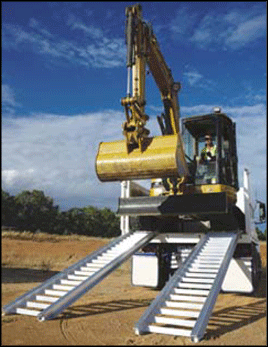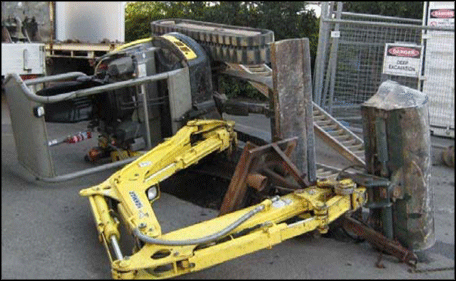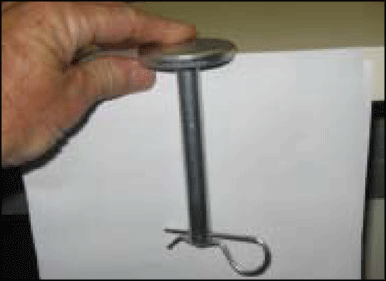Securing loading ramps for mobile plant
Issued: 26 March 2012
Last Updated: 26 March 2012
Purpose
The purpose of this safety alert is to highlight the risks associated with not effectively securing loading ramps for mobile plant (similar to those shown in photograph 1).
Background
In October 2011, a worker was killed after being crushed by a forklift that toppled while being unloaded from a trailer. In the same month, an excavator fell off the loading ramps while being unloaded (see photograph 2).
Both incidents were a result of the loading ramps not being effectively secured.

Photograph 1: Loading ramps for mobile plant

Photograph 2: Excavator ramp incident
Contributing factors
The ramps involved in these incidents are supplied by the manufacturer with purpose designed securing pins with retaining clips (R-clips) (see photograph 3).

Photograph 3: Securing pin and retaining clip supplied with ramps
In the forklift incident, there were no holes in the trailer for the securing pins to be inserted. The ramps were not secured in any other way and were dislodged from the edge of the trailer as the forklift was being unloaded.
In the excavator incident, a bolt was used to loosely secure the ramps to the tray of the vehicle. The bolt was not a component that was supplied or recommended by the manufacturer and did not prevent the ramps from dislodging.
Alternative systems for securing loading ramps may be provided with ramps made by other manufacturers. These systems must also be used in accordance with the manufacturer's instructions.
Action required
Always:
- use the securing components (such as pins and R-clips) that are supplied or recommended by the ramp manufacturer
- follow the manufacturer's instructions for correctly installing and using securing systems
- ensure that the ramps are lined up with the wheels or tracks of plant being loaded or unloaded
- ensure that the ramps are load rated and suitable for the item of plant being loaded or unloaded (including any additional attachments on the plant)
- use seatbelts when loading and unloading
- check that the ramps are not bent or cracked before use.
Never:
- use ramps unless they have been properly secured to the vehicle in accordance with the manufacturer's recommendations
- use fixing components that have not been supplied or recommended by the manufacturer
- use ramps or fixing components that have been damaged
- allow people near the plant while it is being loaded or unloaded.
Further information
The Work Health and Safety Act 2011 imposes health and safety duties on all persons conducting a business or undertaking - whether as employers, self employed people, designers, manufacturers, suppliers, installers and owners of plant, or workers.
More information on the safe use and design of machinery is included in the Managing risks of plant in the workplace code of practice 2021 (PDF, 1.57 MB). Guidance on conducting risk assessments can be found in the How to manage work health and safety risks code of practice 2021 (PDF, 0.65 MB).